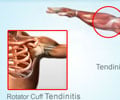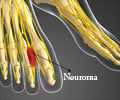- Heel pain - (http://www.mayoclinic.org/symptoms/heel-pain/basics/causes/sym-20050788)
- Haglund’s Deformity - (http://www.foothealthfacts.org/footankleinfo/haglunds-deformity.htm)
- Achilles tendinitis - (http://www.mayoclinic.org/diseases-conditions/achilles-tendinitis/basics/symptoms/con-20024518)
What is Heel Pain?
Heel pain is experienced by most of us and can be disabling at times even though it is not a life threatening condition. The heel is made up by the heel bone, also called calcaneus. It is connected to neighboring bones by ligaments. On the underside is attached one end of a fan-shaped fibrous tissue called the plantar fascia. This fascia is also attached to the bases of the toes. Below the fascia, is fatty tissue, which makes up the heel pad. Behind the calcaneus is attached a tendon called the Achilles tendon. A small cushion like structure called bursa prevents friction in this region. Injury or disease conditions affecting any of these parts including the overlying skin can result in heel pain.

Conditions in which heel pain is present are:
- Plantar Fasciitis – Plantar fasciitis is the inflammation of the plantar fascia extending from the heel to the toes. Most commonly, it occurs in people with flat feet or high arched feet. Use of non-supportive footwear and obesity can also cause plantar fasciitis. Common symptoms include gradual increase in pain on the underside of the heel and in the arch of the foot. Pain is worse in the morning or while getting up after sitting for long periods of time.
- Heel spur – Heel spur is a condition in which a bony growth is formed on the underside of the heel bone. It can happen due to biomechanical imbalance, frequent running or jogging, wearing ill-fitted shoes and obesity. Strain on the muscles and ligaments of the heel can lead to heel spur. Pain is localized to the region where spur is present. Pain is worse after rest or with running/ jumping.
- Sever’s Disease – Sever’s disease is a condition that affects the growth plate of the heel. The condition affects children between the ages of 8 to 14 years who actively participate in sports; the pain becomes worse with walking.
- Achilles tendonitis – Achilles tendonitis is the inflammation of the tendon that extends from the calf region to the heel bone. It is common in athletes who have increased the intensity of their practice or in people who occasionally play tennis or basketball. Pain and stiffness are often located at the back of the leg, usually above the heel bone and are worse in the morning. Symptoms improve with activity.
- Excessive pronation – It is a type of overuse injury. It is common in athletes. Pronation is normal part of the gait. When we stand or run, weight is transferred from the heel to fore foot due to which foot turns inward and the arch of the foot flattens. Excessive pronation causes strain over the muscles, ligaments and tendons in the heel, subsequently leading to injury of the same.
- Achilles tendon rupture – Rupture of the Achilles tendon can be complete or partial. Common symptoms include popping sound at the time of injury, pain and swelling near the heel, inability to stand over toes on the injured leg and to bend the foot forward.

- Unicameral bone cyst – It is a fluid filled cavity inside the bone. It usually occurs in adults. It can affect any bone, but is commonly seen in heel bone. Often, it is asymptomatic and is detected incidentally after a fracture or injury.
- Osteomyelitis – It is an infection to the bone. Infection can happen through blood stream from a distant organ, which is infected or passed on from a neighboring tissue or due to an injury to the bone itself. Most commonly, diabetic patients are prone to infection in the foot. Common symptoms include fever, pain in the foot, swelling, fatigue, warmth and redness over the foot.
- Gout – Gout is a form of arthritis that occurs due to hyperuricemia and deposition of uric acid crystals in the joint. It usually affects the big toe but can affect even the feet, ankles, wrist, hands and knees. Common symptoms include severe pain, reduced range of motion in the joint, warmth, swelling and redness over the heel bone.

- Stress fractures – This can happen due to frequent application of force in the form of jumping over the lower limbs. Heel pain in this condition is not so severe and reduces with rest. Sports, sudden increase in physical activity, osteoporosis and foot problems like flat feet and high arched feet increase the risk of developing stress fractures.
- Tarsal tunnel syndrome – It occurs due to the compression of the posterior tibial nerve, which passes through the inner side of the ankle. Compression of the nerve can happen due to flat feet, abnormal bone spur, varicose veins, ganglion cyst, a swollen tendon, diabetes and arthritis. Shooting pain, tingling and numbness are often experienced in the ankle, soles, heel, in the arch of the foot and over the calf.
- Soft tissue swelling or infection: Infection or swelling of the soft tissue around the heel can result in pain. Inflammation of a bursa called bursitis may produce pain with swelling. Cellulitis or infection in the subcutaneous tissue produces pain, redness, swelling and fever.
- Bone tumor: Bone tumor of the heel bone could be a rare cause of heel pain. A bony swelling may be felt in these individuals.
Shoes and Heel Pain
Our feet support our weight and they take the pressure and strain from all our daily activities like walking, running or standing on hard surfaces. Hence it is no wonder that millions among us suffer from heel pain. Many women are literally ‘married’ to high heel shoes and would rather suffer pain then consider changing their shoes. High heels are the number one cause for persistent heel pain when the cause is related to the foot wear.
The soft tissues of the foot are prone to inflammation if not well supported. Using the right orthotic inserts or insoles can help, however make sure they fit well and are well measured to support the heels or the arches. Sometimes these are expensive to buy but are worth the investment.
When buying shoes test if the shoes has enough support by twisting it using the heel and toe end. If they twists easily it means that it lacks the soles to provide adequate support.
Comfortable shoes that support the arches and the heel are the key in both prevention and treatment of any foot or heel related pain. Never compromise on the quality of the foot wear for the long term good health of your feet.
How to Diagnose the Cause of Heel Pain?
Diagnosis of heel pain consists of evaluation of the underlying condition causing it. X- rays, CT Scan/ MRI are useful in diagnosing plantar fasciitis and heel spurs. Achilles tendonitis or Achilles tendon rupture is diagnosed with physical examination, X- rays, ultrasound and MRI imaging. X – rays, MRI and bone scan are useful in detecting tumors or cysts. Bone biopsy is a confirmatory test in diagnosing osteomyelitis. X- rays and MRI Scan are useful in detecting stress fractures. EMG/NCS are useful in detecting nerve disorders.

How is Heel Pain Treated?
Plantar fasciitis is initially treated with rest, NSAIDs, steroid injections, using orthotic devices, padding or strapping, walking cast and night splint. If patients fail to respond to conservative treatments, surgical options like detaching the fascia from the heel or extracorporeal shock wave therapy can be considered. Applying ice pack in the region of heel spur alleviates acute pain, while calf and foot strengthening exercises provide long-term relief from heel spurs. Use of NSAIDs, orthotic devices are used initially to treat Achilles tendonitis. If this does not help surgical correction is done. Osteomyelitis is best treated with a course of antibiotics for four to six weeks. Along with this, surgical treatment in the form of drainage of the wound, excision of diseased bone and tissue, restoring blood flow and if required amputation of the foot is considered depending upon the severity of infection. Stress fractures usually heal without surgery. Using walking boot or a brace or crutches helps in walking without bearing weight on the foot.
Heel Pain - Health Tips
- Wear proper shoes that are comfortable and support the heel. Using shock- absorbent soles, rigid shanks and supportive heel counters provides support to the heel in the front, back and sides.
- Always do warm up exercises and stretching exercises before any sporting activity.
- Wear appropriate shoes suitable for sports.
- Pay attention to diet you take and maintain a healthy lifestyle with good nutrition and enough rest.
- If obese, take steps to lose weight.
- Roll your foot over a rolling pin or a bottle to relieve heel pain.
Frequently Asked Questions (FAQs)
1. Which doctor should I consult for heel pain?
You should consult an orthopedic surgeon for heel pain.
2. When do I need to see a specialist for my foot pain?
If the answer to these questions is yes then you must see a podiatrist:
- Pain in the heel in the morning when taking the first few steps
- Pain when standing or walking for a long period of time.
- Pain on walking after resting for sometime
3. What is the cause for my heel pain which is severe early in the morning after waking up from sleep?
There could be two possibilities. They are plantar fasciitis and heel spur. You need to get evaluated further with physical examination and X–rays to confirm the cause.
4. What is the role of bone biopsy in osteomyelitis?
Osteomyelitis is the infection to the bone that is passed on from neighboring organs or through blood stream or injury to the bone itself. Bone biopsy is done by taking a sample from the bone. It is done to check for the source of infection.
5. What could be the reason for swelling and pain over my heel that I developed after over stepping from stairs?
It could be a ruptured Achilles tendon. Some people will tell the doctor,' I heard a popping sound in my calf at the time of the fall.'
Rupture to the Achilles tendon can be complete or partial.
You need to check with an orthopedic specialist for examination and investigations like ultrasound of the tendon to conclude on the cause for your symptoms.








